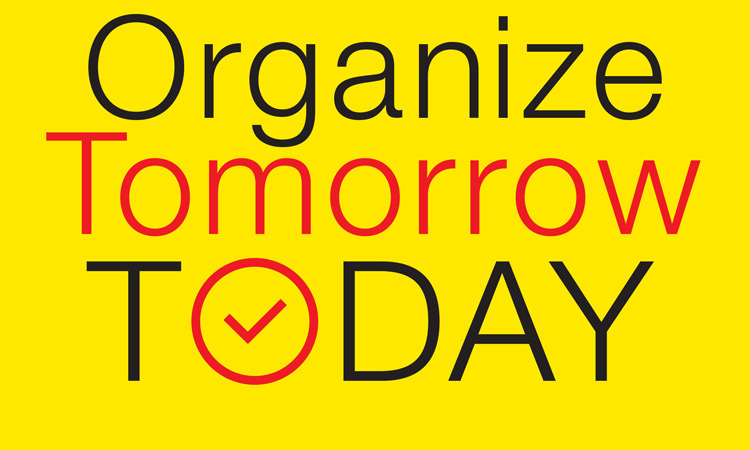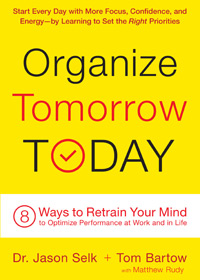 Forget dwelling on problems—that habit will cause paralysis. Instead of brooding, be a doer: relentlessly apply your concentration to finding answers, advises sports coach Dr Jason Selk and business coach Tom Bartow in their new book, Organize Tomorrow Today: 8 Ways to Retrain Your Mind to Optimize Performance at Work and in Life.
Forget dwelling on problems—that habit will cause paralysis. Instead of brooding, be a doer: relentlessly apply your concentration to finding answers, advises sports coach Dr Jason Selk and business coach Tom Bartow in their new book, Organize Tomorrow Today: 8 Ways to Retrain Your Mind to Optimize Performance at Work and in Life.
 Top executives and athletes thrive because habits trump innate attributes, according to Dr Selk and Bartow, who reason that no one needs alpha male traits, because hard work beats talent if you can keep cool through methods including deep breathing exercises. If you are a highly sensitive person dogged by a neurotic personality, beware because overthinking outcomes is fatal, as Selk knows from coaching pitchers and hitters.
Top executives and athletes thrive because habits trump innate attributes, according to Dr Selk and Bartow, who reason that no one needs alpha male traits, because hard work beats talent if you can keep cool through methods including deep breathing exercises. If you are a highly sensitive person dogged by a neurotic personality, beware because overthinking outcomes is fatal, as Selk knows from coaching pitchers and hitters.
“Jason asked the player what he thought about when he stepped in the batter’s box, and the answer was astounding: ‘I’m looking at the Jumbotron and I can’t believe what it says I’m hitting .253 or something,” an anxious player tells Selk. “’It’s so hard to stay in control of your emotions and thoughts when you have everybody watching and you’re under the microscope,’” the player adds.
Selk’s advice is to ignore external results; instead focus on preparation and performance. In line, the player boosts his average dramatically—by more than 30 points through concentration on method.
“Every day, I followed my routine. Every cut. Every ground ball. No matter what the result, I made myself emphasize the process, and I held myself accountable for doing the work,” the player says, adding that the outcome speaks for itself. “Focusing on process flat-out works.”
 According to Selk and Bartow, like the player who raised his game, you can manufacture success and optimism, through refusing to fret and pursuing eight strategies. For example, get organized ahead of commitments, prioritizing aggressively. Besides, maximize your time, quash negative self-talk, and be ready to go the extra mile rather than growing complacent in the wake of success.
According to Selk and Bartow, like the player who raised his game, you can manufacture success and optimism, through refusing to fret and pursuing eight strategies. For example, get organized ahead of commitments, prioritizing aggressively. Besides, maximize your time, quash negative self-talk, and be ready to go the extra mile rather than growing complacent in the wake of success.
As Selk and Tom Bartow state, their doctrine owes a debt to two top-tier pragmatists: investment magnate Charlie Munger and basketball coaching legend John Wooden, who insisted on total training that even extends to tying shoelaces just right for maximum support.
A friend of the late disciplinarian, Bartow is touted as the top business coach in the country. Dr Selk, who trains Olympic athletes and Fortune 100 executives, runs a mental training program for the 2011 World Series Champions, the St. Louis Cardinals, and is the author of another self-help track titled 10-Minute Toughness.
Organize Tomorrow Today sums up the pair’s take on achievement persuasively in snappy style. One nitpick is that their core “mental workout” technique, positive visualization, has been called into question by research published in the Journal of Experimental Social Psychology in 2011. Also, the manual’s tone is intense: one profiled top performer—a National Hockey League ace—works out so hard he almost vomits. Another hard-charger—a financial adviser who proactively calls three clients and one prospect every day—sounds slightly pesky.
 Still, the good habits guide is full of sense and especially hot on the value of listening, which takes up about 65% of communication, the authors say. Yet, almost all related advice centers on how to speak more effectively.
Still, the good habits guide is full of sense and especially hot on the value of listening, which takes up about 65% of communication, the authors say. Yet, almost all related advice centers on how to speak more effectively.
“Rarely are you prompted to learn to listen better,” state Selk and Bartow, adding that we badly need to focus on that side of the equation. “We get so caught up in planning what we’re going to say next that we don’t pay full attention to what the other person is actually saying,” they say. So leave some air between sentences. Slow down at least 20% more than you think necessary, whether you are talking face-to-face or over the phone.
Phone calls still count, it seems, because personal connections must still be made. Alas, again, we spend half of each call waiting for the other person to pause, so we can announce what we want to say, according to Selk and Bartow. Worse, the dialog is even more jumbled because of the lack of observable body language.
So strive to be more attentive and, no matter how much you have already achieved, keep improving, focused on methodical, incremental gains. Cultivate the grit to make your upgrades stick—grow habitual through repetition, repetition, repetition. Becoming your best self is hard, Selk and Bartow accept but brook no excuses.
The trick is to mix with others who habitually hold themselves accountable because, when the pressure mounts, they remain at the top of their game. “They are the all-stars, the leaders, the consistent winners in life.”
To find out about Rose’s thoughts on how to live a happier life, click here



2 Comments
MartinK
I’d like to comment on this quote:
“One nitpick is that their core “mental workout” technique, positive visualization, has been called into question by research published in the Journal of Experimental Social Psychology in 2011.”
I think it’s safe to say that the research by Oettingen actually supports rather than contradicts Selk’s method. His visualizaiton technique involves visualizing the process, not the outcome. What Oettingen’s research shows is ineffective is visualisation of the outcome only (i.e. classic Law of Attraction visualization).
Oettingen’s own method includes visualization. You first visualize the outcome, and then how you can/will overcome the obstacles in your way.
Gianna Caiola
Hi Martin,
Thanks so much for the comment! We always love hearing how research can be interpreted in so many different ways. I think what our author was trying to say that although both methods use visualization, one disputes how effect visualizing the end-goal can be. Ottingen states that the mind “relaxes” after visualizing the end goal as if it has already attained it, which can often stop a person from trying to achieve the goal in real life. Whereas Selk is saying that the feeling of achieving the end goal can instead be used to motivate just as much a visualizing the “struggle” to get there (as Ottingen suggests).
Hope this clears it up for you.
Much Love,
RWM Staff